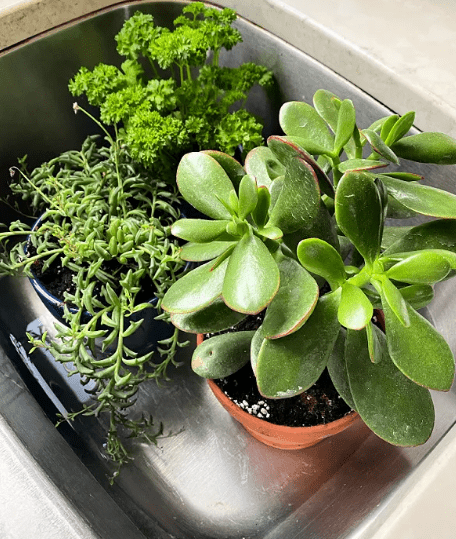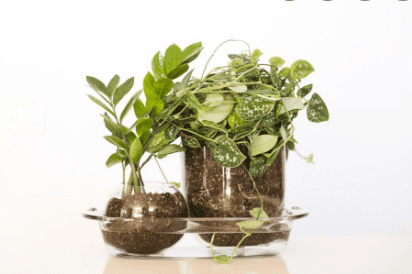
Bottom watering is an efficient method of watering plants that you always worry about overwatering. Bottom watering should be done on a timetable to avoid overwatering even though it is effective.
Watering the bottom should be done every three to four days. This allows the soil’s water to hydrate the plant and move the minerals around so they are more easily available for absorption. How quickly water dries out and how frequently it becomes bottom water depends on the wind, humidity, and temperature.
You must give your plants the proper amount of water at the right time to prevent them from drying out.
We have discussed what you need to know about how frequently to bottom water your plants and what circumstances affect the schedule, as watering plants from the bottom up is not an exception.
Table of Contents
What is Bottom Watering?
By setting the plant in a tray of water that is 1 to 2 inches high, bottom watering is accomplished. Following this, the water is allowed to drain freely, leaving the soil moist and aerated. The water is subsequently absorbed into the soil from the bottom up.
Watering the bottom:
- encourages the formation of strong roots
- prevents gnats and other pests
- minimizes overwatering
- enables the soil to breathe fresh air
Why Bottom Watering?
When developing healthy plants, watering is a crucial habit. The most typical way to water them is by drizzling water directly onto the top of the potting soil, a practice known as top watering.
While most plants benefit from this type of watering, certain plant species do not respond best to this type of irrigation.
For instance, if water is dropped on some plants’ leaves, such African violets, the leaves become blotchy and discolored.
The moisture may not seep into the soil if your plant is developing roots and may instead run down the sides of the pot.
These issues can be avoided by watering potted plants from the bottom, which also more effectively hydrates the soil.
Once you understand how to water your plants from the bottom, you’ll save time and work and provide a healthier environment for your plants.
How Long Does Bottom Watering Take?
The pot is submerged in water when being watered from below. The plant absorbs the necessary quantity of water for its correct operation and healthy growth in about 15 to 20 minutes.
When the soil surface is damp, the pot can be taken out of the water. Place the pot back where it belongs after letting the water drain.
Before the soil may be bottom watered once more, it is moist for three to four days.
The optimal time to water plants from below is in the spring and summer when the plant uses the most water within a day of the last watering.
The exceptions include orchids, cacti, and succulents.
A Quick Note: We should always check to see if the plants are dry before watering them from below whenever we get new plants from nurseries.
Check to see if the plant roots are still alive after moisturizing the earthy coma.
When to Remove the Plant from the Tray?
After 15 to 20 minutes, remove your plant from the tray filled with water. It’s crucial that you avoid letting your roots sit in water.
After 20 or 30 minutes, merely pour the extra water into a bucket.
How to Measure Soil Moisture?
Minerals, air, water, solutes, organic matter, and vital plant nutrients make up the soil (especially nitrogen).
When caring for a garden at home, it’s critical to ensure that the soil is well-drained, aerated, and favors water retention so that the plant can utilize all the nutrients for growth.
The soil’s moisture and the length of time it takes to finish the procedure might be influenced by the time of day and location you select.
There are various ways to assess soil moisture, and doing so can be very useful in figuring out how moist the soil is and when to water the plant.
Let’s go over them in more depth.
Finger Test Method
The moment in which potted plants are watered is crucial. Between the container wall and the plant stem, insert your finger into the dirt.
It’s time to water the plant if you press down on the second knuckle and the soil is still dry.
Find a large enough container to hold the pot, and half-fill it with distilled or filtered water. Too much chlorine is frequently present in tap water, which harms plants.
Put the pot inside the container, then step away for ten minutes.
If the substrate hasn’t absorbed enough water, recheck the humidity level in the container.
Keep the pot submerged in the water for a further 20 minutes, if necessary, to allow it to absorb as much water as possible if the surface is still dry. Eliminate extra water.
Bottom-watered plants maintain uniform root moisture, but they do not clear the salt and mineral buildup that eventually accumulates on top of the soil.
Once each month, water from the top should be applied to the soil to rinse it and get rid of any extra minerals. Until the soil’s bottom drains, squirt water over the soil’s surface.
Stick Method
- As deeply as you can, drive the wooden stick into the ground. Take care around the roots.
- For five minutes, leave the stick on the ground. The stick will have more time to absorb the water from the soil as a result.
- Take the stick out. The substrate is damp if the stick has a watermark or dirt on it. If the soil is dry and the color has not changed, you should water the plant from the bottom up.
- To reuse the stick later, sanitize it and let it dry.
Soil Moisture Meter
A simple and reliable tool for measuring soil moisture is the soil moisture meter.
The soil moisture meter displays the present moisture content in absolute percentages as well as the soil’s wilting point or saturation level.
The simplest meters are a form of hygrometer that detect soil moisture levels using humidity sensors.
displaying the humidity level frequently as a decimal figure, a percentage, or a color-coded scale from 1 to 10, where lower values represent drier soil and higher numbers represent wetter soil.

Best Moisture Meter for Measuring Soil Moisture:
- Soil moisture meter, XLUX
Use this reasonably priced soil moisture meter from amazon to eliminate the guesswork in knowing how much moisture your soil has.
A great and affordable moisture meter to use when determining whether to water your plants is the XLUX Soil Moisture Meter.
Simply bury the XLUX Soil Moisture sensor in your garden or potting soil, wait a few seconds, and then check the gauge to see how moist the soil is. Just that.
You may avoid issues like overwatering and underwatering by understanding the moisture content of your soil.
- Tester for soil VIVOSUN
The reasonably priced Trazon Soil 3-in-1 Meter can be used to measure the soil’s pH and moisture content. It checks the pH as well as the amount of moisture and light. Clicking here will take you there!
Additionally, this 3-in-1 Plant moisture sensor meter is portable and simple to use.
How does soil type affect watering time?
The best growth is guaranteed by soil that has been loaded with clay minerals, which help improve and more uniformly distribute moisture.
This soil offers good drainage during rainy summers and winters, preventing waterlogging.
The presence of a lot of spaces between soil particles defines sandy or sandy loam soil.
Due to them, there are fewer capillaries in the soil and gravitational forces are stronger, which has an impact on how moisture is distributed laterally and causes it to flow downward.
Due to the greater density of capillaries in clay soil, water moves outside the distribution point to the right and left.
The gravitational indications that direct moisture downward are diminished at the same time. Low water permeability results in the root zone retaining moisture for an extended period of time in such soil.
The downward outflow of moisture is significantly more constrained in compacted clay soils.
Such soils may experience water stagnation as a result of overwatering, which will hinder plant root growth.
The capillary movement’s ideal properties in medium-heavy soils are: Loams contain 75% dust and 15–25% clay.
See our in-depth post for more information on how bottom watering impacts soil quality and vice versa, affecting how long it takes to bottom water plants.
The Takeaway:
Overall, the majority of plants only require 15 to 20 minutes to absorb the necessary moisture.
Before the soil may be bottom watered once more, it is moist for three to four days.
For normal operation and healthy growth, you can bottom water your plants twice a week.
FAQ
Can you overwater a plant by bottom watering?
Yes, you can still overwater your plant by watering from the bottom if it has been submerged in water for too long. Bottom watering is a more controlled way to water your plants, though.
Should plants be watered from the bottom?
If your plant’s roots are becoming entangled, moisture may not penetrate the soil and may instead run down the planter’s sides. These issues can be avoided by watering potted plants from the bottom, which also supplies moisture to the soil more effectively.
How long is too long for bottom watering?
After 10 minutes, check the soil; if it is still dry, extend the time to 20 minutes. You may accurately bottom-water your plant in this manner. To avoid overwatering, don’t leave your plant for longer than the recommended 10-15 minutes.
How long should plants sit in bottom watering?
If you want to try bottom-watering, it’s actually fairly easy. Pour some room-temperature water into a bowl or saucer, and if necessary, add some fertilizer. From this point, you can just put the plant in the container and wait for around 15 minutes. (Larger pots may require more time!)
How long should u bottom water plants?
If you want to try bottom-watering, it’s actually fairly easy. Pour some room-temperature water into a bowl or saucer, and if necessary, add some fertilizer. From this point, you can just put the plant in the container and wait for around 15 minutes. (Larger pots may require more time!)
